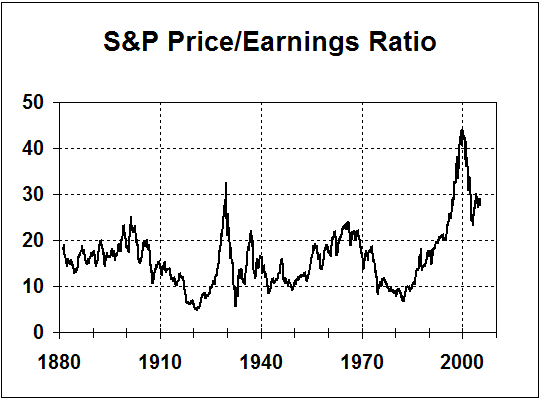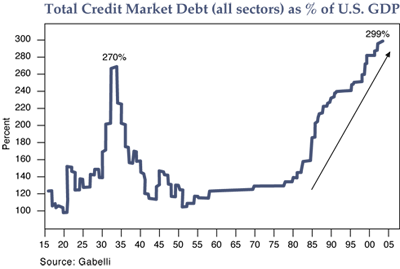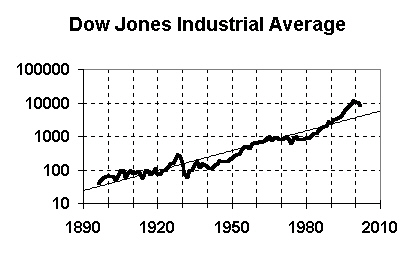
Dynamics

|
Generational Dynamics |
| Forecasting America's Destiny ... and the World's | |
| HOME WEB LOG COUNTRY WIKI COMMENT FORUM DOWNLOADS ABOUT | |
(This article originally appeared in the July 6 issue of Warren Pollock's Macroeconomic Newsletter.)
Friday's (2-Jul) unemployment report was a shock to many analysts, because they had been so wrong. They had almost uniformly predicted that 250,000 net jobs would be created in June, but in fact only 112,000 net were created. Even worse, the figures appeared to be establishing a downward trend, already two months old, supported by other negative trends, including weak retail sales. Analysts are saying that the chances of slipping back into recession are real.
Fed Chairman Alan Greenspan must have had mixed emotions about the figures, since he's been bragging for several months that, in essence, the economy has been following the path that he set for it in 1997. But even he may be wondering if things are in as good a shape as he'd like, especially after the sharp disagreement that the 78-year-old chairman has been having with younger members of the Fed committee, as revealed by the newly released May meeting minutes.
The disagreement concerns whether or not inflation is back in force. Greenspan says it isn't, and so the Fed can raise interest rates very slowly, slowly enough so as not to disrupt the stock market. The younger Fed governors don't see it that way. Inflation has been a major concern their entire professional lives, and they don't have the same worries about a stock market collapse that Greenspan might.
And little wonder: Born in 1926, and concerned about his legacy as Fed chairman, Greenspan is very worried that he's reliving a childhood nightmare, the devastation of the Great Depression. Greenspan must remember growing up in the 1930s, with massive starvation and homelessness all around him, and learning that the cause was a stock market bubble that ran in the 1920s, and finally burst with the 1929 stock market crash. He remembers learning in school that the devastation that such a stock market bubble could never happen again, because President Franklin D. Roosevelt's administration had created the SEC and instigated new regulations that would prevent any such bubble from happening again.
But it did happen again -- and under Greenspan's watch in the late 1990s. And Greenspan knew all along we were in a bubble, according to a January, 2004, speech where he bragged, "There appears to be enough evidence, at least tentatively, to conclude that our strategy of addressing the bubble's consequences, rather than the bubble itself, has been successful. Despite the stock market plunge, terrorist attacks, corporate scandals and wars in Afghanistan and Iraq, we experienced an exceptionally mild recession, even milder than that of a decade earlier." So the Fed knew we were in a bubble, and decided not to stop it, but instead to deal with the crash, whenever it occurred. As we now know, his solution, starting in early 2000, was to lower interest rates to near-zero, thus making huge amounts of low-cost credit available to prevent bankruptcies and homelessness.
Did he prevent these consequences, or merely postpone them? Unfortunately, Generational Dynamics, a historical methodology that analyzes historical events based on the flow of generational changes, says that those bankruptcies are still coming, and they're unavoidable. And Greenspan should have realized this.
The 1990s bubble occurred at precisely the time that the generation of people who grew up during the 1930s Great Depression disappeared -- retired or died -- all at the same time.
Those growing up during the Depression were originally called "depression babies," but in the 1950s Time Magazine gave them the nickname "the Silent generation," because they valued conformity and loyalty above all else, and didn't complain about much.
It was this highly risk-averse Silent generation that grew into middle management positions in the 50s and 60s, and took senior management positions in the 70s and 80s. By 1990, probably every financial institution in the country was being led by, or at least heavily influenced by, the experience of Silents.
But a big change happened in the early 1990s: Most of the Silents disappeared, through either death or retirement, and the senior management positions were taken up by the Baby Boom generation of kids, born during or after World War II. These kids grew up in a world where America had beaten the Depression and beaten the Nazis, and thus had nothing to fear from anyone or anything. Since the early 90s, senior management positions all over are being filled by people from the risk-seeking, arrogant, hubristic, narcissistic, self-assured "baby boomers." This is a huge change for every institution in the entire country.
 |
For the financial industry, it meant forgetting the lessons of the 1920s, and going into a state of denial about the new bubble that the stock market entered in the late 1990s. The level of denial has to be truly huge to ignore what the adjacent graph is saying. It tells you that, since 1880, whenever the Price/Earnings ratios go above 20, then they soon drop below 10. That means that we can soon expect the Dow to fall to around 4000, and the S&P index to fall to 400.
The level of denial is astonishing. Consider Stock Prices and Fundamentals in a Production Economy (PDF), a Fed policy paper published in January, 2000, the absolute height of the bubble, when P/E ratios were around 40. It says, "In the late 1990s, the US stock market has taken off, leaving conventional valuation benchmarks such as dividend yields or P/E ratios very far from historical averages. Several recent analyses have suggested that the old benchmarks no longer apply because the US economy has entered a period of faster growth and lower required returns--two changes that imply a large runup in equity markets in the familiar ... growth model."
What the above means is that the "internet bubble" wasn't a bubble. How could anyone possibly believe that? Computer industry analysts were pointing out that there weren't enough potential customers in the world to recover even a small fraction of the venture capital being expended for software development or to use even a fraction of all the fiber optic cable that was being laid, or to pay off a tiny fraction of the money promised in conjunction with all the stock options being granted. There was literally no chance at all that the high stock valuations could be maintained. And yet we have this Fed policy paper.
What it says, in essence, is that we've counted on price/earnings ratios to guide us for decades, but we won't use them any more, because they're not giving us the answers we want.
That's the kind of thing that separates the Silents from the Boomers. The younger managers think they know only that inflation is the big danger, because that's all they've ever seen. The "know" that another Great Depression is impossible, because FDR's administration abolished it forever. Greenspan, who lived through the Great Depression, saw it, heard it, smelled it, tasted it, knows that he can see some of the same things today, smell some of the same smells, taste some of the same tastes.
Greenspan isn't the only one who's worried. The problems have been evident for a while. In March, 2003, when the Dow was around 8,000, master investor Warren Buffett, born 1930 into the Silent generation, declared, in Berkshire Hathaway Inc.'s annual report, that stocks were still significantly overpriced (at 8,000!!!), despite three years of falling prices, and that "the insanity of valuations reached during The Great Bubble" had yet to work themselves out.
 |
And things have only gotten worse in the year since Buffett made those remarks according to Bill Gross, head of the PIMCO bond fund, the world's largest. He says in his May/June 2004 Investment Outlook that his 3-5 year economic forecast is much more negative than last year's because there's "more U.S. consumer leverage dependent on cheap financing; more Treasuries in foreigners' hands; more geopolitical instability; and more risk of a slowdown/shock in Asia." In short, "the conditions for instability have accelerated" in the last year.
Stephen Roach, chief economist at Morgan Stanley, agrees with Gross that accelerating debt, especially consumer debt, has already reached the tipping point. "This has all the ingredients for disaster," he says. "It will take nothing short of a miracle to extricate the self-indulgent American consumer from this mess."
 |
But there's no miracle in sight. My own original prediction, made in Spring, 2002, was that we were entering a new 1930s-style Great Depression. This prediction was based on the adjacent graph which shows that the DJIA is currently way above the exponential growth trend line. (You get a similar result for the S&P index.) Call it a law of nature if you want, but the real underlying value of the businesses represented by the stock market must grow at an exponential rate, no faster or slower. If the capitalized value is above the trend line, then it must soon thereafter fall below the trend line. There's no choice. This is about as close as you can get to a mathematical proof that the DJIA must fall to the 4000 range and the S&P index to the 400 range, before 2010. Nothing has happened since I made this prediction to cause me to think it's in error.
So that explains why Greenspan has been having mixed emotions over the unexpectedly negative employment report last week. On the one hand, it shows that the economy may be quickly heading for the the 1929-like downward spiral that he fears the most; but on the other hand, he can use the weak data to convince the younger Fed committee members to keep interest rates low. If he's very, very lucky, that will postpone that downward spiral until after he retires in 2006, when one of the Boomers will have to deal with it.
Greenspan's January 2004 speech was to the annual meeting of the American Economic Association in San Diego, and can be found at http://www.federalreserve.gov/boarddocs/speeches/2004/20040103/default.htm.
I'd like to thank Dr. Warren Jacobs, founder of Conservative Investment Strategies, for pointing out to me the paper "Stock Prices and Fundamentals in a Production Economy," written by Michael T. Kiley of the Federal Reserve Board at http://www.federalreserve.gov/Pubs/Feds/2000/200005/200005pap.pdf.
Warren Buffett's comments were in Berkshire Hathaway Inc.'s annual report at http://www.berkshirehathaway.com/2002ar/impnote02.html.
Bill Gross's comments were in the PIMCO "May/June 2004 Investment Outlook" at http://www.pimco.com/LeftNav/Late+Breaking+Commentary/IO/2004/IO_5_04.htm.
[End of article]